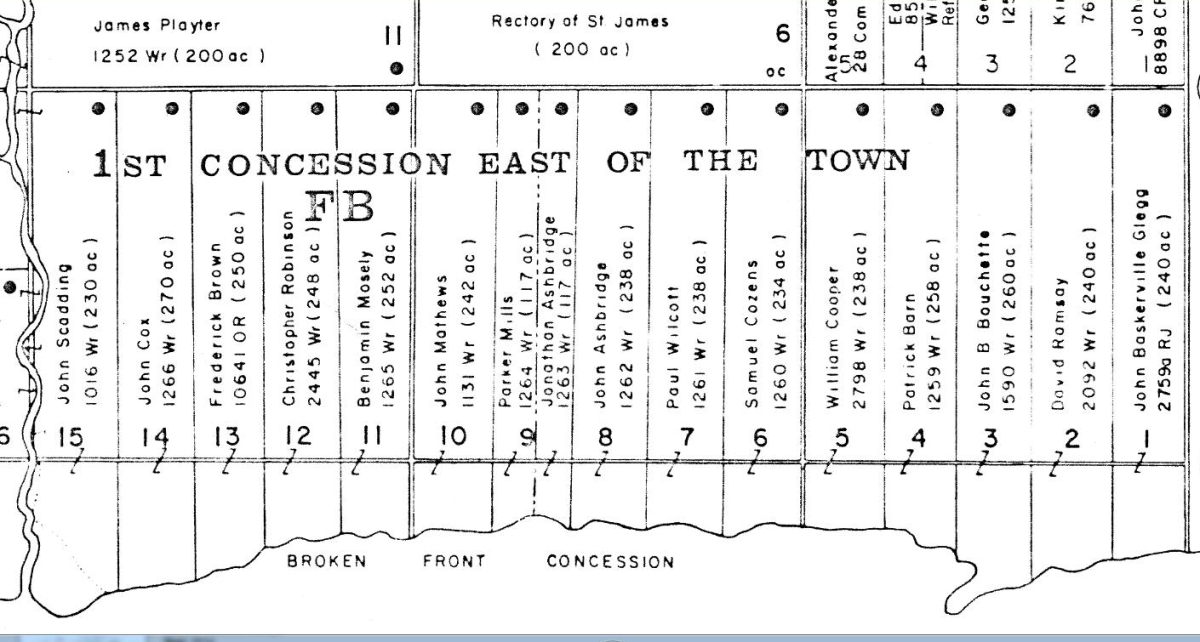




City Engineers Map 1892 Showing the boundaries of the City of Toronto as “City Limit” in red. The lot lines still show, but streets hadn’t been built on them yet. The lot lines were the farm boundaries and had muddy lanes the farmers used to access their fields. Coxwell Avenue is a rough dirt road.

In the 1896 map, E.H. Duggan, a real estate developer, now owns the farms between Woodfield Road at the east of the Ashbridge Estate and Coxwell Avenue. He has subdivided the area directly west of Coxwell Avenue that includes Rhodes and Craven, holding it for future development.
Erie Terrace is not yet built on. Houses show on the map as little black rectangles. Rhodes Avenue is very faintly marked between Gerrard and the railway tracks. Upper Gerrard exists as does lower Gerrard but they are both not much more that rutted dirt trails. If you look carefully at the very bottom of the map at the lower right you can see an estate marked “E. Simpson”. A knitting mill was built there in the 1860s by one of the most enterprising and important business men in the area, Joseph Simpson (1824-1898). I will write a separate story about this intriguing Jewish businessman from Charleston, South Carolina who panned for gold in the 1848 California Gold Rush and came to Canada as a “draft dodger” because he did not want to fight for the Confederacy. Ernest Simpson, the E. Simpson on the map, was his son.


In the 1893 map Reid Avenue (now Rhodes Avenue) has been laid out north of the track. The subdivision has been registered (the numbers in the oval). South of the tracks no road has been opened up yet Erie Terrace (Craven Road) is now a registered subdivision (see the number) and has been divided up into tiny lots on its side. Coxwell Avenue has also been subdivided all along its west side to Danforth Avenue. Duggan intentionally developed Erie Terrace as a “shacktown” with tiny houses on tiny lots and no infrastructure. At the same time, he held back the farm to the west, intending it to be developed later for more lucrative lots with more substantial houses. That is why the west side of Erie Terrace (Craven Road) was not built on.


In this 1903 map, Erie Terrace is not yet built on. Houses show on the map as little black rectangles. Rhodes Avenue is very faintly marked between Gerrard and the railway tracks. Upper Gerrard exists as does lower Gerrard but they are both not much more that rutted dirt trails. If you look carefully at the very bottom of the map at the lower right you can see an estate marked “E. Simpson”. A knitting mill was built there in the 1860s by one of the most enterprising and important business men in the area, Joseph Simpson (1824-1898). I will write a separate story about this intriguing Jewish businessman from Charleston, South Carolina who panned for gold in the 1848 California Gold Rush and came to Canada as a “draft dodger” because he did not want to fight for the Confederacy. Ernest Simpson, the E. Simpson on the map, was his son. Joseph Simpson grazed his own sheep where Gerrard Square is today. Only the best wool was good enough for his Toronto Knitting Mills.




Duggan has developed Ashdale Avenue as a slightly more upscale working class street than Erie Terrace (Craven Road). The backyards of the houses on Ashdale extend to Erie Terrace. There are no houses, therefore, on the west of Erie Terrace — just a few sheds. The houses are little rectangular squares. The ones in yellow (all of them) are made of wood or are roughcast (stucco and wood). Erie Terrace is on the right. There are, of course, shacks scattered all over “Shacktown” but they were not considered even houses by the those who drew up this map for fire insurance purposes. So they are not marked. Morley Avenue is Woodfield Road. Applegrove became part of Dundas Street in the 1950s.
The subdivision and lot numbers are clear on this 1910 map, making it easier to research the history of individual houses. Robin Burgoyne of Caerwent House Stories is that expert on this.
See more at http://www.housestories.ca/





I know many people may not enjoy maps. So I put this one last map in as a reward for those who don’t like maps but read this post anyway.

